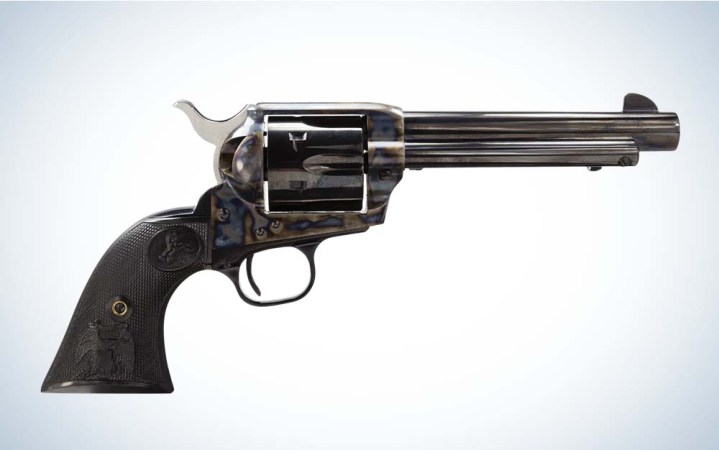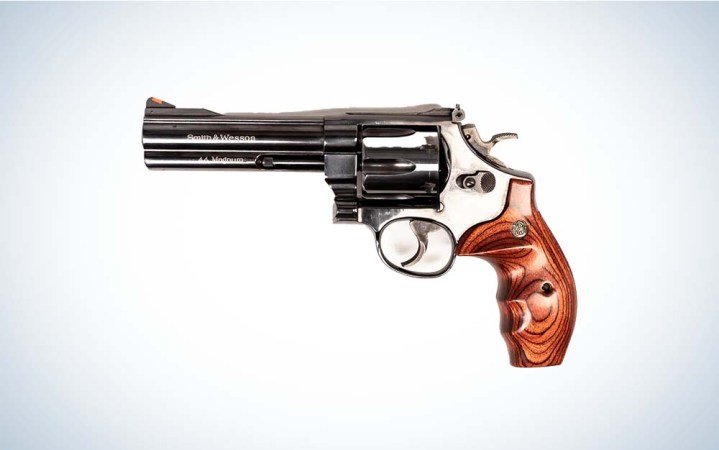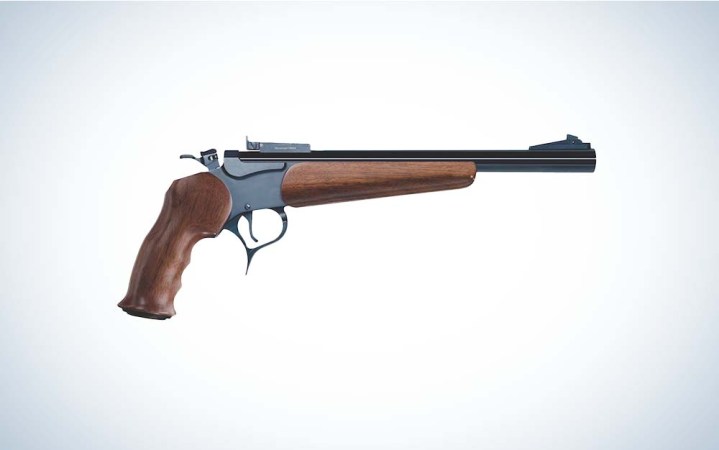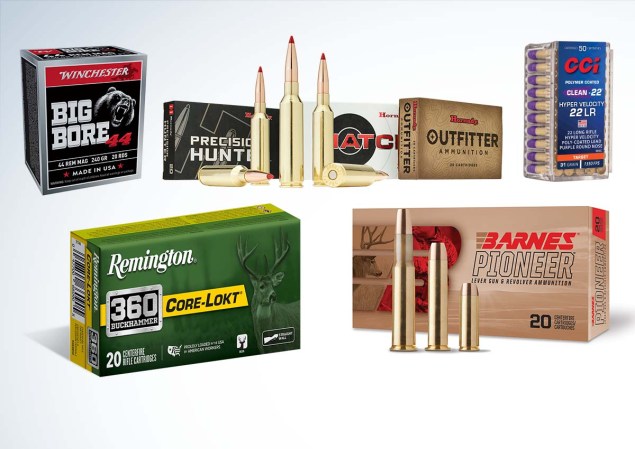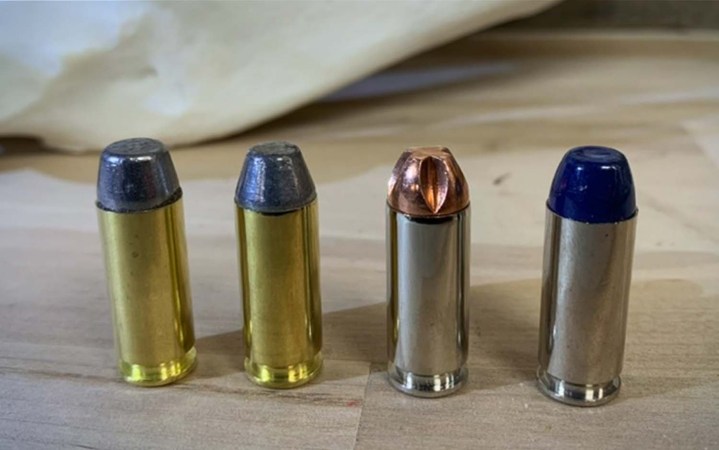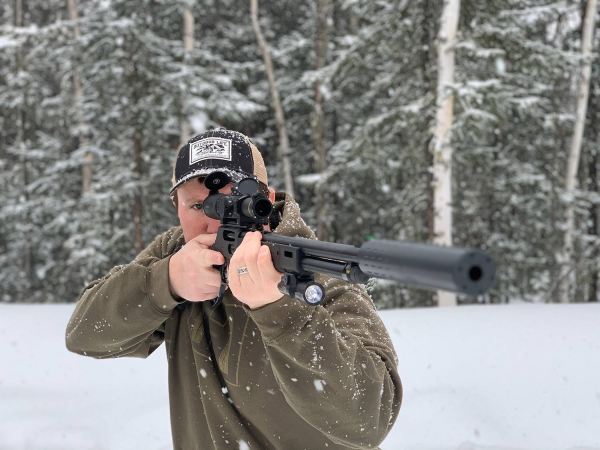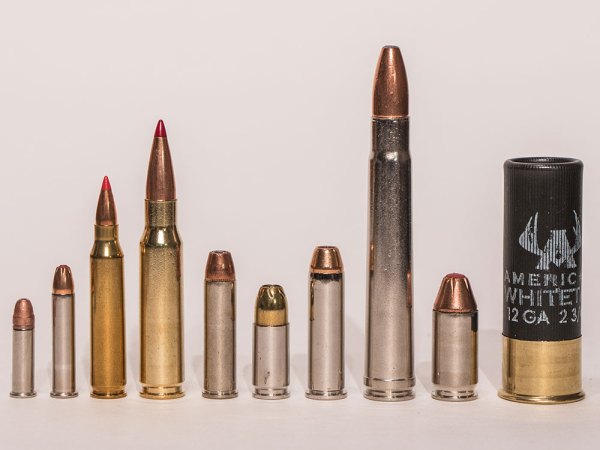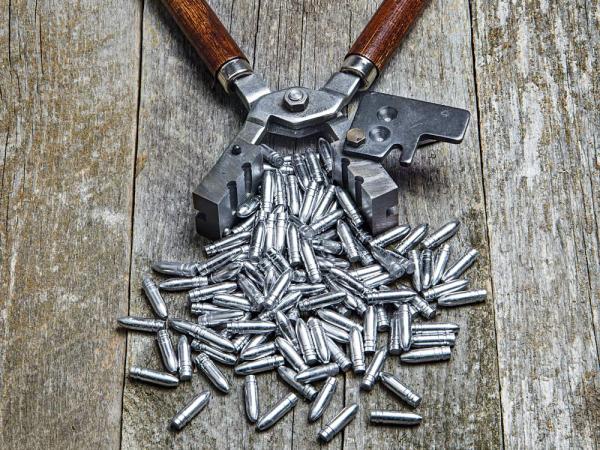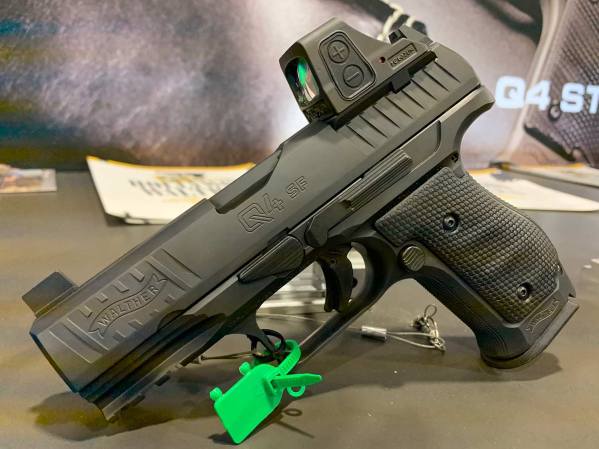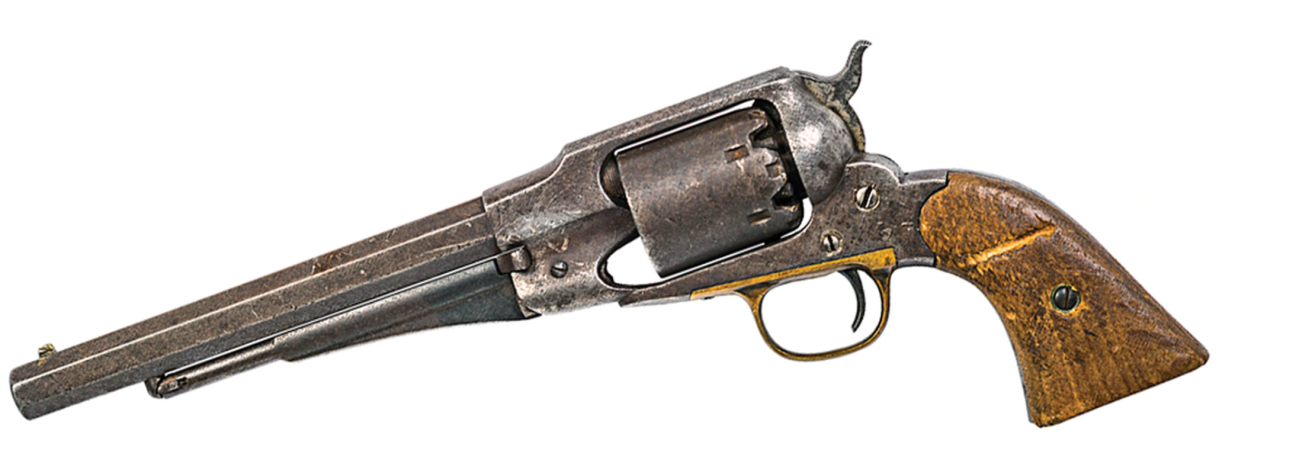We may earn revenue from the products available on this page and participate in affiliate programs. Learn More ›
While today’s best handguns are modern marvels of speed and accuracy, it would be a mistake to forget about the classic pistols that got us here. Samuel Colt started the revolver evolution with his pistol, which debuted in the late 1800s and was made famous by real cowboys and then countless Westerns on the silver screen. In the decades between Colt’s revolver and the modern guns of today, there’s a large roster of pistols that American shooters should know about—and should have in their gun safes. My job was to pick my seven favorites. The firearms that follow influenced many of the revolvers and semi-autos we carry today.
1. Colt Single Action Army
Sam Colt was bored while crossing the ocean on a slow boat in 1830 and to pass the time he carved out a wooden model of a repeating handgun. He is said to have invented the modern revolver with the results.
Colt later made a huge mistake when he dismissed an idea from one of his gunsmiths, Rollin White, who wanted to do a “bored-through” revolver cylinder to allow the use of metallic cartridges in a handgun. After Colt fired White for daring to suggest an improvement to his revolver design, White took his idea to Smith & Wesson. They patented his invention and blocked Colt from building cartridge firearms for almost 20 years.
When the S&W patent ran out in 1873, Colt introduced the Single Action Army pistol in .45 Colt, perhaps the most famous revolver in history. We see it in every western ever made, Marshal Dillon is shown drawing it at the start of every Gunsmoke episode, and it’s the gun everybody thinks of when they hear “cowboy gun.”
Winchester’s 1873 rifle is called “The gun that won the west,” and rightly so. But, the Single Action Army was right beside it. The Single Action Army Colt, matched with the .45 Colt centerfire cartridge, launched the modern era of handguns. Its mark on handgun history is indelible and deep.
2. Colt 1911
For a lot of core handgun shooters one fighting pistol stands alone: the 1911. A lot of internet experts believe it’s an antiquated design chambered for an unnecessarily large cartridge, and that it does not hold enough ammo. I believe that everyone is entitled to his or her opinion, but anyone who thinks the platform is obsolete is simply wrong.
The 1911 served through two world wars and 100-plus years of use by military, law enforcement, and civilians. This gun has won every type of handgun competition on earth. The inarguable truth is that the 1911 has more than proven its durability, reliability, stopping power, and its accuracy.
The .45 ACP dates to a war the United States fought in the Philippines from 1899 to 1902. The U. S. forces were using double action revolvers chambered in an anemic cartridge called the .38 Long Colt. But too many of our fighting men were being killed with machetes even after hitting the enemy with every bullet in the gun. This experience, combined with the controversial Thompson-LaGarde Test of 1904, led the Army and the Cavalry to decide that a minimum of .45-caliber was required in the military’s new handgun. John Browning developed the .45 ACP in 1904 and it was adapted to the Browning-designed semi-auto pistol in 1911.
While both the pistol and the cartridge have undergone some modernization, the 1911 remains, at least in the minds of many gun savvy people, the best pistol and cartridge team available. There are innumerable 1911 options out there today, including some very high-end models like the Nighthawk Custom President. The only downside is the relatively small magazine capacity, at least by today’s standards.
3. Browning Hi-Power
The Browning Hi-Power was John Moses Browning’s final handgun design. He was working on it when he passed away.
The Hi-Power was introduced in 1935. A defensive pistol with a cult following, the Hi-Power has seen plenty of service with law enforcement and military, particularly in Europe. The design is a bit old and antiquated by modern standards, but the Hi-Power is still a relatively small, all metal handgun with a long history of reliable performance. The double-stack 9mm magazine holds 13 rounds and some aftermarket magazines will hold 15 rounds.
The gun is not without its critics. It has a magazine safety that prevents the gun from firing without a magazine inserted. This is undesirable and unnecessary in a fighting gun. Also, the hammer can hit the shooter’s hand as the short beavertail does not protect you from the hammer spur. A bloodied hand is a common complaint from Hi-Power shooters.
Browning dropped the gun from production in 2017, but the market has seen the introduction several clones recently, such as Springfield’s SA-35 and the FN High Power, which address some of the original designs shortcomings. It was a great gun that still might have legs in these new iterations. There are far better choices today, but for years the Hi-Power was the ultimate 9mm handgun.
4. S&W N Frame Model 27/29
Before 1935, handguns were mostly defensive tools. Relatively low powered, they were not considered hunting or even sporting guns. Then along came the .357 Magnum and the S&W Registered revolver. That handgun evolved into the Model 27 and while the Model 27 was important to cops, it also launched the modern civilian concept of magnum revolvers.
The gun used the large N frame and it was a highly polished work of art. Later S&W introduced the lower priced, less polished Model 28. This was my first handgun. Like a fool, I traded it away.
In 1955, the N frame was used again to introduce the new .44 Magnum cartridge and the Model 29 revolver. This might well be the best-known modern revolver, due in great part to Clint Eastwood using it in his “Dirty Harry” movies.
There was a time when every serious handgun shooter had one or both of these guns. I can remember the early days of IHMSA competition when 75 percent of new shooters showed up with a Model 29. Gun writer Elmer Keith had a big hand in developing both cartridges. He made the .44 Magnum famous well before Clint ever picked one up. His story of hitting a wounded mule deer at 600 yards with his .44 magnum is legend.
The N frame, .357 Magnum and later .44 Magnum, revolvers are likely responsible more than any other firearm for launching the sport of handgun hunting. They can each kill a deer cleanly and the .44 Magnum is capable of taking down some of the biggest game in the world.
5. Nagant M1895 Revolver

Millions of Mosin-Nagant rifles, standard issue for Russian troops in their fight against the Nazis during WWII, flooded the surplus market just a few years ago. The bolt guns, primarily chambered in 7.62x54mm R became widely popular due to cheap ammunition. What a lot of folks don’t know is that Léon and Émile, the Nagant brothers, also cooked up a handgun for the Russians. Their revolver was an engineering marvel with its sliding cylinder and extended firing pin.
It used a special 7.62 mm cartridge with the bullet buried deep in the case. The case mouth is flared and when the gun is cocked the cylinder slides forward until this flared case mates to the back of the barrel. This seals everything and eliminates the problems associated with the conventional cylinder-to-barrel gap found in traditional revolvers.
To reach deep into the gun after the cylinder is moved to the forward position meant that the hammer-mounted floating firing pin was more than three-quarters of an inch long. So when the Nagant is cocked, it has a very distinctive profile.
The Nagant revolver was made in two designs, a double action for officers and a single action for the masses. By 1933, Russia started to replace the gun with the Tokarev semi-automatic pistol. The military gave up on it completely with the introduction of the Makarov pistol in 1952. The Nagant remained in use with the Russian Railways, postal service, and police forces for many years. In fact, the postal security service used it until 2003.
6. Thompson-Center Contender
Working in his home shop in New Hampshire, Warren Center developed a unique, break-action, single-shot pistol. In 1965, Center joined the K.W. Thompson Tool Company and they introduced the handgun as the Thompson-Center Contender in 1967. The gun could easily switch barrels so that you could buy one gun and multiple barrels. The sights or scope stayed with the barrel so it held zero when you switched. The gun was initially chambered for low-pressure, low-recoil cartridges like the .22 LR, .22 WMR, .22 Hornet, .38 Special, and .22 Remington Jet.
They added more cartridge options, including a .45 Colt/.410 shotgun version. T/C dropped the .410-bore barrel in favor of a .44 Magnum and .357 Magnum that used plastic shot capsules. In fact, I have one in .44 mag. Later they brought back the .45/.410 and I bought one immediately. I can’t tell you how much game I have shot with mine—grouse, rabbits, squirrels and even pheasants, but it’s a lot.
The Contender didn’t sell all that well at first. It was just too “different.” Then IHMSA long range competition shooting started to take off in the late 1970s. So did handgun hunting. The gun proved itself for long range competition and eventually they had to develop a separate category just for the Contender. It was so accurate and chambered in cartridges that outclassed any revolver.
Bob Milek, a gun writer, teamed up with Steve Herrett, who made custom handgun grips, to develop the wildcat .30 Herrett and the .35 Herrett cartridges based off the .30/30 case for the Contender. They were high performance, both for hunting and for IHMSA. In fact, the first Production Class perfect 40 score was with the .357 Herrett. I have one that I hunted deer with for years and competed with as well.
The list of cartridges offered grew very long and it included many magnum handgun and many low pressure rifle cartridges like the .30/30, .35 Remington and even the .45/70. J.D. Jones developed his line of JDJ cartridges for hunting. Later T/C added a few of them to their lineup, including my favorite the .375 JDJ.
The improved G2 version came along later, as did the upsized Encore handgun that could handle .30/06 class cartridges and larger with ease. It was even offered in the T-Rex appropriate .416 Rigby. That really put T/C in the front line of handgun hunting. In 2006, Smith &Wesson bought T/C and the Contender faded away.
Read Next: Pocket Pistols for Personal Protection
7. Remington XP-100
The Remington XP-100 (experimental Pistol number 100) is a bolt-action pistol produced by Remington Arms from 1963 to 1998. It was first chambered for the .222 Remington, but muzzle blast was pretty serious with the short 10-inch barrel. Remington shortened the case and called the new cartridge the .221 Fireball.
The center-grip, nylon stock had racy lines and white diamond inlays. The barrel wore a vented rib that ended with a shark’s fin front sight. Often called the Buck Rodgers space gun, the XP-100 was certainly a product of the space race years between Russia and the U.S.
The XP-100 was later changed to include a longer barrel and, in some versions, a rear grip stock. Stocks were changed to fiberglass or wood, including laminated wood. A multitude of short action cartridges were offered as well.
In IHMSA competition the rush to knock over the 50-pound rams at 200 yards inspired some crazy stuff. I once shot an XP-100 in a shortened .458 Winchester Magnum. The guy developed it for IHMSA competition, but the recoil was brutal and I don’t remember ever seeing his name on the winner’s list.
The XP-100 was based on the Model 600 rifle action and was very accurate, dominating the IHMSA open class. In response to the competition demands Remington offered it in a couple of BR style cartridges with no factory ammo available, trusting the consumer to manage handloading.
The XP-100 also fed the growing handgun hunting market in the late 1990s. It could easily handle modern, high pressure rifle cartridges and was appropriate for hunting just about anything on earth. In the right cartridge it could reach well into long range territory. I once shot an Alabama whitetail with my .260 Remington rear-grip XP-100 that would have been a very long shot even for a rifle.
Many companies copied the bolt action concept in an attempt to cash in, with Weatherby and Savage springing to mind. More recently, Nosler introduced a version as well.
I have a few XP-100 handguns and have taken a lot of game with them, but I never was able to find one of the original short barrel .221 Fireball that I could afford. My story on that is simple. By the time I was out of high school and working so I could afford one I had become a “sophisticated gun guy” who knew it all and I decided it was a foolish pistol, designed for foolish children. Decades later I grew to understand how foolish I was in those years, but the gun had attained collector’s status by then and the price grew well past what I wanted to pay.
Still, The XP-100 changed the world by introducing and perfecting the concept of high-performance, long-range handguns.

